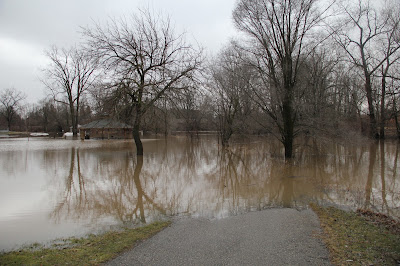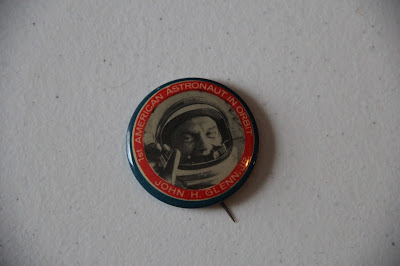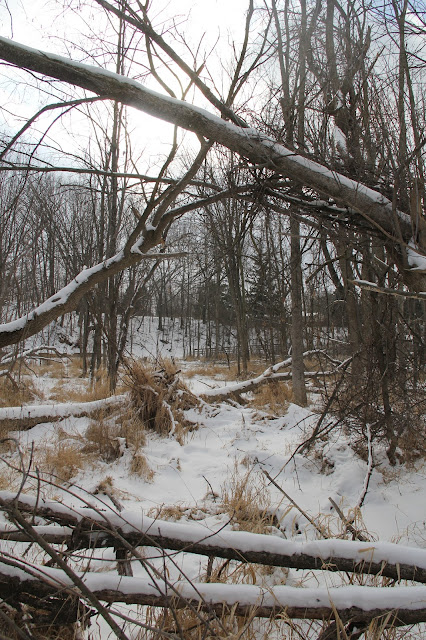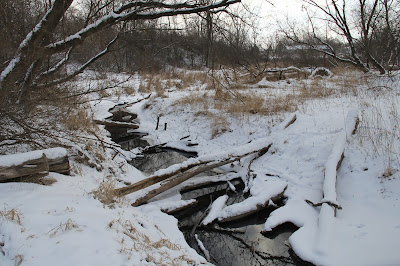 |
| A male Red-winged Blackbird (Agelaius phoeniceus) flashes its red and yellow epaulets. |
Tuesday, February 27, 2018
They're baaack...
The Red-winged Blackbirds (Agelaius phoeniceus) have begun returning to Mid-Michigan. I thought I saw one last Friday evening. This evening I definitely spotted two on the outskirts of Alma. Within a few days I expect they will be everywhere. To me the return of the Blackbirds is the first real sign that spring is on its way.
Thursday, February 22, 2018
High water (21 FEB 2018)
Over the last several days, Mid-Michigan has experienced between 1.5 and 2.0 inches of rain. Add in melting snow and many local rivers have gone past flood stage. Here are a few photos from Mt Pleasant's Mill Pond Park, Island Park, and Pickens Field taken early yesterday morning. Most of these areas flood on an annual basis or even more frequently.
Mill Pond Park
Island Park/Pickens Field

Mill Pond Park
Island Park/Pickens Field

Tuesday, February 20, 2018
First American in Orbit - 20 February 1962
On 20 February 1962, Astronaut John Herschel Glenn, Jr. became the first American to orbit the Earth in the "Friendship 7" spacecraft. Two Soviet cosmonauts had previously orbited the earth in Vostok spacecraft. The first human in space, Yuri Gagarin made one orbit in the Vostok 1 and Gherman Titov made 17 orbits in the Vostok 2.
Born 20 July 1921 in Cambridge, Ohio, John Herschel Glenn, Jr. served in the United States Marine Corps as a fighter pilot during both World War II and the Korean War. After the Korean War, he remained in the service as a test pilot. In 1959, we was named as one of the first seven American astronauts (the Mercury Seven).
Glenn was the third American to be launched into space as part of NASA's Project Mercury - flights by Alan Shepherd (Freedom 7) and Virgil "Gus" Grissom (Liberty Bell 7) each lasted approximately 15 minutes.
When John Glenn safely landed he instantly became a national hero. His flight was commemorated by dozens (probably hundreds) of different souvenir items (including the buttons shown in this post).
In 1964, Glenn resigned from NASA to run for the United States Senate. He withdrew from the race due to symptoms of a concussion that did not allow him to campaign. After losing a second senate campaign in 1970, he was finally elected to the office in 1974. Glenn would go on to serve in the Senate until 1999.
While serving in the Senate, Glenn returned to space one more time aboard the the Space Shuttle Discovery. As a trained engineer, Glenn's role during STS-95 (29 October - 07 November 1998) was to participate in experiments that tested the effects of weightlessness on the elderly. It also allowed NASA the opportunity to study the effects of space flight on an individual at points in life more than three decades apart.
With this flight, John Glenn added another milestone to space travel. In addition to being the first American to orbit the Earth, he is also the oldest person to travel into space.
John Glenn passed away 08 December 2016 in Columbus, Ohio at the age of ninety-five.
Monday, February 19, 2018
Happy Presidents Day 2018
 |
| Theodore Roosevelt National Park near Medora, ND |
Happy Presidents Day!
My favorite U.S. President was also one of the nation's greatest champions of conservation.
 |
| North Dakota Badlands at Theodore Roosevelt National Park |
Theodore Roosevelt was President of the United States from 1901 to 1909. During his time as President, Roosevelt created designated five national parks; signed the Antiquities Act and used its powers to designate eighteen national monuments, including Devil's Tower (the nation's first) and Grand Canyon; oversaw the creation of the U.S. Forest Service and designated 150 national forests; and designated more than fifty wildlife refuges, including the nation's first at Pelican Island. Roosevelt's conservation legacy was honored with the creation of Theodore Roosevelt National Park near Medora, ND. Roosevelt spent parts of several years as a rancher in the area during the 1880s and much of his future conservation ethic was influenced those years.
 |
| Devil's Tower was designated the nation's first National Monument in 1906. |
Thursday, February 15, 2018
Sunset and Hawk (14 February 2018)
 |
| Red-tailed Hawk at sunset |
I spied this Red-tailed Hawk (Buteo jamaicensis) outside the Saginaw Chippewa Academy last evening. It lined up perfectly with the sunset and allowed me to take several photos.
 |
| Another view of a Red-tailed Hawk silhouetted against the sunset |
 |
| A closer view of the hawk |
Tuesday, February 13, 2018
Adaptations - Stratification
 |
| Wild Leek waiting out the winter months |
A simple definition of the word adaptation is a physical trait or behavior that helps a living organism survive in its habitat. Every living organism has adaptations. Physical adaptations are easy to see - think the spots on a fawn or the thorns on a rosebush. In animals behavioral adaptations can be easy to observe, such as hibernation during periods of extreme cold or heat. Behavioral adaptations in plants are more difficult to recognize.
One behavioral adaptation that can be observed is stratification. While some seeds of some plants are capable of germinating immediately upon maturation, for other species this would be less than ideal. For instance, early germination might mean that a plant begins to grow at the wrong time of the year. A plant that requires 90 days of warm weather to grow and develop flowers and seeds would not want to sprout and begin growing in September when it will be killed by cold within weeks.
Instead, many seeds experience a period of dormancy once they mature. Stratification is an adaptation that allows the seeds to break that period of dormancy and then sprout. Many seeds require a period of cold stratification. This means that they must experience an extended period of cold temperatures before they will come out of dormancy. One good example of a plant that goes through cold stratification is Common Milkweed. I have planted milkweed seeds in spring that did not undergo stratification. Rather than sprouting, they remained in the ground dormant all summer before finally sprouting the following spring (after a winter in the ground). Many summer and fall wildflowers require this type of stratification.
 |
| Common Milkweed seeds need to undergo cold stratification before they can sprout. |
Other wildflowers require a more complex hot-cold stratification, requiring a long period of warm weather followed by a period of cold weather. Many spring wildflowers such as Bloodroot (Sanguinaria canadensis) fit in this category. Other species such as Wild Leek (Allium tricoccum) require a multi-year hot-cold-hot-cold stratification process. All of these different stratification requirements can be very frustrating when trying to start a wildflower garden from seed.
Monday, February 12, 2018
Watch the 2018 Winter Olympics!
 |
| Shara posing for a picture at the US Olympic Training Center at Lake Placid, NY back in 1998 or '99. |
A break away from the usual science and nature blogging to remind everyone that the XXIII Olympic Winter Games are currently taking place in Pyeongchang, South Korea.
We love the Winter Olympics in our house. I was too young to remember the 1980 Lake Placid Games, but since the 1984 Sarajevo Games I have eagerly awaited the arrival of each Winter Olympics.
The Winter Olympics feature few sports that are familiar to most Americans. Most of the sports are never shown on the major American broadcast networks with the exceptions of ice hockey, alpine skiing, figure skating, and snowboarding.
But, once very four years we are reminded of other winter sports such as bobsled, luge, cross country skiing, ski jumping, skeleton, etc.
My favorite moment of this Olympics so far was watching American Chris Mazder place second in the men's single luge. Why is this such a big deal? Luge has been competed in the Winter Olympics since 1964, but no American man had ever won an individual medal.
In cross country skiing, American Jessie Diggins placed 5th in the women's skiathlon, 14.7 seconds behind the gold medal time. This the highest finish by an American woman in Olympic cross country competition. The other big story in this race was the silver medal finish by Norwegian Marit Bjorgen. This was her eleventh Olymic medal! She is now the most decorated female Winter Olympian of all time. In the men's skiathlon, Norwegian Simen Hegstad Krueger was involved in a crash at the very start of the race, but came back to lead a 1-2-3 sweep by Norway.
I eagerly anticipate the rest of these Olympic Games. I hope everyone will tune in to watch the games and support the athletes from every country as they pursue their Olympic Dreams. Unlike professional athletes in basketball, football, and baseball, most of the athletes in these sports will never become rich. Many of them work other jobs during the year to support their participation in the sport. They compete for the love of their sport. Passion like this is something to aspire to. In other countries besides the United States, Olympic competitors and especially Olympic champions are celebrated as national heroes. Unfortunately, this is something we do not do very well in the United States - once the games are over these athletes go back into the shadows where they continue to work to improve so they can represent their country in the sport they love. These men and women should be revered for their athletic prowess and devotion to something that they love.
Watch the Olympics! Be a fan and supporter of all Olympic athletes.
Friday, February 9, 2018
A Winter day at Mill Pond Park (08 February 2018)
Yesterday, during the middle of the day, I was able to spend a little more than an hour walking through Mill Pond Park. This 90 acre park is located along the Chippewa River right in the middle of Mt. Pleasant.
Despite its location, this park is home to a diverse collection of wildlife. Although I saw only a few birds and one squirrel (plus a feral cat), I did find lots of evidence of animals including tracks and evidence of feeding.
Like other parks in the city, Mill Pond Park has lost large numbers of trees due to an Emerald Ash Borer infestation. As these trees fall it can be very difficult to travel off trail within the park.
I was surprised to find several trees that showed evidence of beavers. There have been beavers in the park many times, but these trees were nearly one hundred yards from the river. Despite this distance, it was obvious that the beaver had visited this site multiple times
Despite its location, this park is home to a diverse collection of wildlife. Although I saw only a few birds and one squirrel (plus a feral cat), I did find lots of evidence of animals including tracks and evidence of feeding.
 |
| Tracks on ice at the river's edge |
 |
| Ice flows in the Chippewa River |
 |
| A Fox Squirrel high in a tree at Mill pond Park |
 |
| A gentle curve of the Chippewa River |
Like other parks in the city, Mill Pond Park has lost large numbers of trees due to an Emerald Ash Borer infestation. As these trees fall it can be very difficult to travel off trail within the park.
 |
| Fungi on a dead tree |
 |
| A deer trail through the woods |
 |
| A clump of reeds along the edge of the marsh |
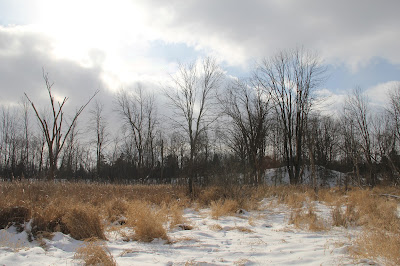 |
| Looking south over the marsh |
 |
| Dramatic clouds |
I was surprised to find several trees that showed evidence of beavers. There have been beavers in the park many times, but these trees were nearly one hundred yards from the river. Despite this distance, it was obvious that the beaver had visited this site multiple times
 |
| Vole of shrew tracks on the ice |
 |
| Looking down at the spillway of the Mill Pond dam |
 |
| Trees and ice on the Chippewa River |
 |
| Ice formed in patches on one of the weirs that slow the rivers drop |
 |
| I like how the shape of the trees is repeated by the shape of the clouds |
Subscribe to:
Comments (Atom)












